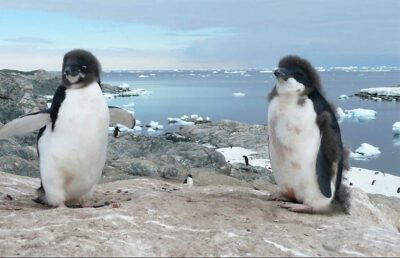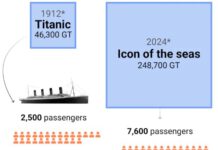
The loss of some 154,000 breeding birds, breeding across 52 islands along the 100 km of coastline, is in stark contrast to other populations in East Antarctica, where there have been long-term increases or stable population trends (see Penguin Heaven).
It is also contrary to model predictions of a continued increase in this population following decades of sustained growth.
Australian Antarctic Division seabird ecologists, Dr Louise Emmerson and Dr Colin Southwell, said the rate of decline is similar to that in Adélie penguin populations on the Antarctic Peninsula, which are subject to external pressures from fisheries, climate change and human activity.
However, the decline in the Mawson population is thought to have been triggered by changed environmental conditions, and then exacerbated by internal feedback processes within the population, rather than direct human-related pressures.
“We think this population decline was initially triggered by five years of extensive summer sea ice adjacent to the colony in the mid-2000s, which hampered access to the adults‘ foraging areas and saw virtually no chicks survive,” Dr Emmerson said.
“The frequency of these unfavourable breeding conditions subsequently remained high, and fledgling survival also began to decrease. These two processes together resulted in a more rapid population decline than would be expected if they had been acting in isolation.”
Safety in numbers
Dr Emmerson said it’s possible that the smaller a population becomes, the harder it may be for individuals to survive, due to an increased risk from predators, or because smaller groups are not as good at navigating, foraging and locating prey. This is especially important for young fledglings with limited life experience.
“It may be that the old adage of safety in numbers is playing out for the fledglings in the vast and harsh Southern Ocean, although exactly why and how needs further investigation,” Dr Emmerson said.
“We estimate that this population has lost about 80,000 fledglings in a good breeding season, compared to the population peak in the early 2000s.
In the deep end
Adélie penguin fledglings are literally thrown in the deep end at about two months of age, when they leave the colony and enter the Southern Ocean for the first time, without parental supervision.
“I remember watching fledglings enter the water for the first time and they did this strange kind of breast stroke, as though they were trying to use their flippers to stand up. It was a completely new experience for them,” Dr Emmerson said.
“When they first enter the water they don’t know how to swim, they have no predator avoidance behaviour, so they are vulnerable to being eaten by leopard seals, and they’re not efficient at catching prey. They’re totally clueless about their marine environment, and because there are no adults to help them they have to learn quickly or they don’t survive.
“So while we don’t know exactly what’s driving the decline in fledgling survival in the Mawson area, the fact that there are less of them may compromise their chances of survival.”
Long-term monitoring
Dr Emmerson said the next step was to continue research to understand the drivers of fledgling survival during their first naïve winter journey at sea after they leave the colony, and ensure any resumption of fisheries activities in the area is managed carefully.
She said continued long-term monitoring across the environmental range where penguins breed was critical for early detection of population decline and for understanding population changes.
Long-term monitoring of Adélie penguins by Australia, near Casey, Davis and Mawson research stations, is also critical to decisions made by the Commission for the Conservation of Antarctic Marine Living Resources (CCAMLR), in managing krill fisheries and in considering the protection of terrestrial and marine areas.
As this study shows, long-term monitoring allows scientists to uncover intrinsic factors involved in population decline that may be concealed by population changes caused by year-to-year variability in environmental conditions. This is critical to informing predictive population models that tend to focus on environmental drivers of population change.
“Model predictions based on external environmental factors alone may fail to accurately predict future population change and/or underestimate the real impacts of climate change on species‘ populations,” Dr Emmerson said.
“Whether this Mawson penguin population stabilises, continues to decline, or recovers, remains to be seen. It is clear from this study though that where possible, we are better off preventing impacts in the first place, or trying to alleviate them before population decline is well-established, or the processes causing the decline become confounding and result in rapid population declines.”
Australian Antarctic Division
www.antarctica.gov.au









